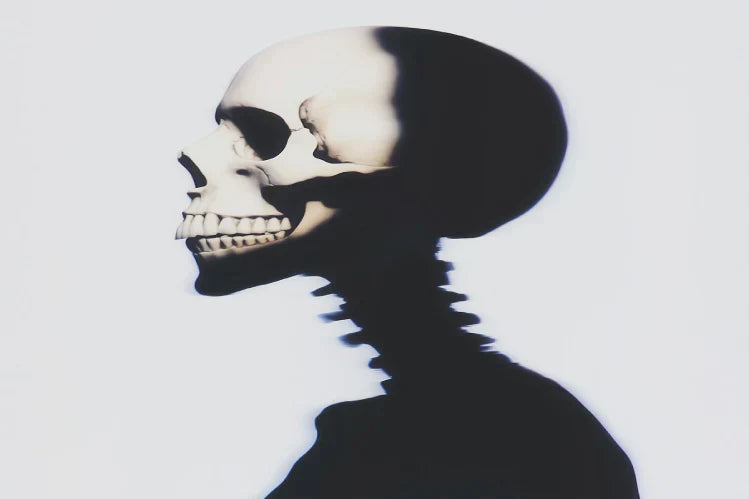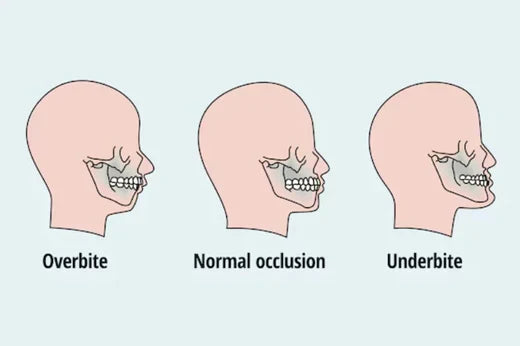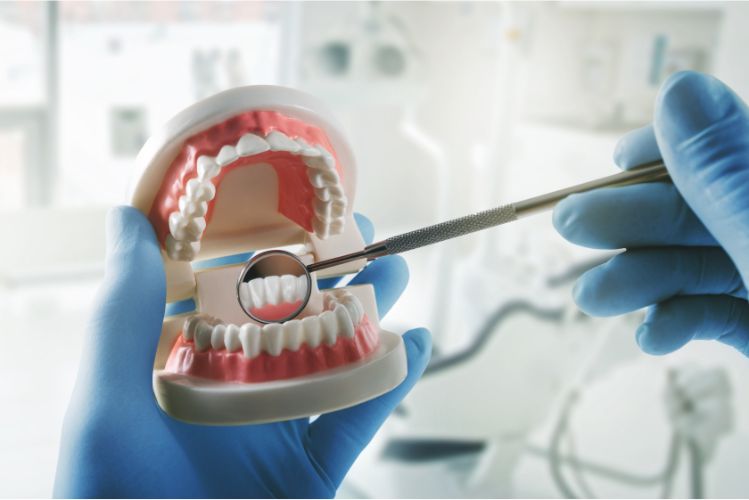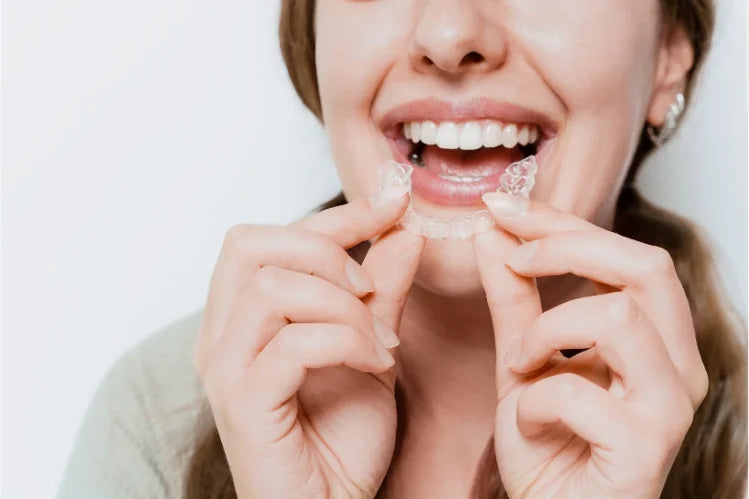
Table of Contents
- What is An Overbite?
- Symptoms of Overbite
- Causes of Overbite
- Genes
- Childhood Habits
- Developmental Issues of Jaw
- Excessive Nail Biting
- Tumors and Cysts of Mouth or Jaw
- Bruxism
- Complications Associated With Overbite
- Tooth Decay or Damage to Gums
- Sleep Apnea or Other Breathing Problems
- Difficulty in Biting and Chewing
- Disfigured Facial Features
- Speech Impediments
- Treatment Options for Overbite
- ALIGNERCO Clear Aligners to Fix Overbite?
- Key Takeaways
- FAQs
You hear a variety of words and jargon when you visit a dentist. Among all those technical terms, have you ever heard the word “overbite” and wondered what it is actually? In this blog, we will try to understand the term overbite, its causes, and why treating it is essential. Let’s find out how ALIGNERCO can help you fix it.
What is An Overbite?

Overbite is a kind of malocclusion in which the upper teeth overlap the lower teeth vertically, more than they should. A slight overbite is necessary and is common in most people. However, more severe overbite, when left untreated, can be problematic and should be evaluated by your dentist.
Difference Between Overbite and Overjet

Overbite and overjet are often considered the same but there is a slight difference between both.
- An overbite refers to the vertical overlap of upper front teeth over lower teeth.
- Like overbite, an overjet is also a kind of malocclusion. It is a horizontal protrusion of the upper front teeth over the lower teeth.
While they both can occur simultaneously, they are distinct issues. The good news is that ALIGNERCO can resolve both of these issues without disturbing your ease. Read till the end to know how.
Symptoms of Overbite
The main symptom of overbite is that your upper teeth excessively overlap your lower teeth. Other symptoms are as follows:
- Enamel erosion
- Breathing issues
- Difficulty in chewing
- Recurring gum diseases
- Jaw pain and headaches
- TMJ disorders
- Speech difficulties
Causes of Overbite
There can be multiple reasons that trigger an overbite. Understanding these causes is important to select the appropriate treatment options for yourself. Have a look at some of the factors that cause overbite:
Genes
Overbite is often hereditary. If overbite runs in your family, there is a good chance that it is present in your DNA. You are more prone to developing an overbite if you inherit a smaller jaw.
Childhood Habits
Several childhood habits like thumb-sucking, tongue-thrusting, or prolonged use of pacifiers can exert unnecessary pressure on the upper jaw, causing it to move forward. When these habits cause serious dental problems if they continue past the age of 3 or 4 or while the permanent teeth are appearing. The pressure created by the sucking can cause the permanent teeth to come in at an abnormal angle.
Developmental Issues of Jaw
Sometimes the jaw remains underdeveloped or is overdeveloped causing overbite. If the jaw is too small to fit all the teeth, the upper teeth overlap the lower teeth excessively, causing a deep overbite. Similarly, if the jaw is larger than normal, it creates gaps between the teeth. This changes the alignment of the front teeth, causing the appearance of overbite.
Excessive Nail Biting
Nail-biting applies constant pressure to the upper teeth, mainly the upper incisors. Over time, this repetitive pressure causes the upper teeth to shift forward, increasing their overlap with the lower teeth. If this habit remains consistent throughout childhood, it causes the underdevelopment of the lower jaw, pushing it a little backward and making the overbite more pronounced.
Tumors and Cysts of Mouth or Jaw
The tumors and cysts in the mouth or jaw affect the alignment of teeth and the shape of the mouth. They cause pain, soreness, or lumps in the upper jaw, making the overbite more pronounced. Due to the persistent swelling or a growth in the upper part of the mouth, the teeth shift forward, and overbite is formed.
Bruxism
Bruxism worsens the overbite due to the excessive pressure it places on teeth and jaw. Excessive grinding and clenching of teeth exerts repetitive pressure on the front teeth. This erodes the enamel and causes the teeth to move forward.
Complications Associated With Overbite
There are multiple health risks associated with overbites. Whether your overbite is a naturally occurring or a conditional issue, you may experience some health issues.
Tooth Decay or Damage to Gums
Maintaining oral hygiene when you have an overbite can be challenging. When oral hygiene is not properly maintained, it causes cavities and bacteria which lead to tooth decay and gum disease.
Sleep Apnea or Other Breathing Problems
When we sleep, our jaw and airways interact. People with an overbite have a small or recessed lower jaw. This pushes the tongue backward, narrowing the airways. This reduced airway makes it harder to breathe, leading to sleep apnea and other breathing disorders.
Difficulty in Biting and Chewing
Due to teeth misalignment of teeth, it becomes challenging to bite and chew properly. The pressure, caused by biting and chewing, is not properly distributed and is exerted only on certain points. When we bite or chew forcefully, it triggers jaw pain along with headaches, earaches, and TMJ disorders.
Disfigured Facial Features
Overbite affects the overall symmetry of the face. Overbite pushed the lower jaw backward and upper jaw forward. This makes the chin look smaller or recede. Overbite also causes lips to protrude or appear less defined. In short, overbite alters the overall balance of the face and disturbs its symmetry.
Speech Impediments
An overbite, particularly a severe one can contribute to speech impediments. To pronounce certain words and sounds, tongue position is very important. An overbite makes it difficult for the tongue to reach the necessary positions. This can lead to difficulties with consonants like "s," "z," "sh," and "ch."
Treatment Options for Overbite
Ignoring overbite causes more harm and no good. So, it's important to get them corrected in time. There are several non-surgical methods and surgical ways for overbite correction. Some of the treatment options are given below:
Clear Aligners
Modern dentistry allows you to correct overbite without braces. Clear Aligners can be used to treat mild to moderate issues of overbite. These are the custom-fit trays. They are made up of clear plastic to make them invisible. These are cost-effective and require fewer dental visits. They gently pressure the teeth and push them back to their ideal state.
Traditional Braces
Traditional braces are effective in correcting overbite. Many people get braces in childhood, but adults can benefit from them too. Traditional braces have been the go-to solution for treating overbites for decades but they are visible and uncomfortable. They require a lot of consistency and time for the treatment.
Palate Expansion
Palatal expansion is a dental device effective to treat overbite in children or adolescents, whose bones are still developing. These are used by children who have too small upper jaw to accommodate permanent teeth. Palatal expansion gradually widens the upper jaw, making room for incoming teeth.
Surgery
In case of severe overbite, your dentist may recommend jaw surgery to reposition the jaw into its original place. This method is specially used for people who reached the growth limit, to correct the relationship between the upper and lower jaws. The biggest disadvantage of surgery is that it is invasive, costly, and requires a lot of time and patience for recovery.
ALIGNERCO Clear Aligners to Fix Overbite?
Many people in the US alone are facing overbite issues, so ALIGNERCO has come up with its game-changing clear aligners. Now, you don't have to worry about your overbite because ALIGNERCO offers affordable and discreet clear aligners, made of high-grade medical plastic for your comfort. These aligners take 4-12 months to treat the overbite, almost half of the time as compared to that of braces. The duration varies depending on the severity of the case.
ALIGNERCO Clear Aligners are 50% less costly as compared to traditional braces. The clear aligners offered by ALIGNERCO exactly fit the arch of your teeth. We make sure your teeth appear properly aligned from all sides and angles so that you get instant happiness when you see yourself in the mirror. You don't require frequent dental visits to get your dream smile. You will receive the aligners at your doorstep.
What Sets Us Apart
We are practically living in the most technologically advanced era, so, why not incorporate technology into our dentistry to innovate our smiles? What sets us apart is that we have introduced a 3D smile projection model to allow you to see how your smile will look like after the treatment even before the treatment is started. Imagine how this will feel to see your transformed smile in advance. Sounds exciting, right?
Key Takeaways
Choosing the perfect solution for overbite is important to protect your oral health and overall well-being. It can impact your confidence and self-esteem but with the solutions like that offered by ALIGNERCO, achieving a beautiful and confident smile is more accessible than ever. So, don't wait, order your pair of clear aligners now!
FAQs
1. Can aligners fix severe skeletal overbites?
Clear aligners are good for treating mild to moderate bite issues. For severe skeletal overbites, the intervention of other treatment options becomes necessary along with clear aligners.
2. What is the main cause of overbite?
There are multiple causes of overbite including thumb-sucking, tongue thrusting, and prolonged use of pacifiers. The overbite could be hereditary or cause tumors or cysts in the mouth or jaw.
3.How do I maintain results?
After getting the treatment, it's important to retain your outcomes so that your teeth don't shift back to their previous misaligned state. To prevent this, retainers are used.
Citations
Santos-Longhurst, A. (2019, March 21). What causes buck teeth (Overbite) and how do I treat them safely? Healthline. https://www.healthline.com/health/buck-teeth#managing-malocclusion
Overbite. (2024, June 25). Cleveland Clinic. https://my.clevelandclinic.org/health/diseases/21473-overbite
Hanoun, A. (2024, October 22). Overjet vs Overbite: Differences and Treatment Options. Infinite Orthodontics. https://infiniteortho.com/overjet-vs-overbite-treatment-options/
Allen, J. (2024, March 12). Overbite: Causes, risks and treatment — Woodsprings Dentistry. Woodsprings Dentistry. https://www.woodspringsdentistry.com/blog/overbite-causes-risks-and-treatment









